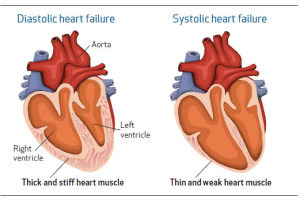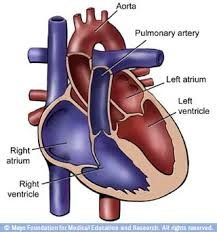Normal Heart vs Right Failure Left Failure
Look at the size difference of the chambers and the muscle of the heart thick/stiff or weakened so proper filling of blood is affected terribly depending on the degree of heart failure on the Rt. or Lt side. The worse it is the worse the signs and symptoms will be due to the failure.
Common causes of left-sided failure include the following:
Drinking too much alcohol/Heart attack/Heart muscle infections/High blood pressure /Hypothyroidism /Leaking or narrow heart valves/Any other disease that damages the heart muscle/Poor left-side heart function due to prior heart attacks
Causes of right-sided heart failure include:
left-sided heart failure already existing spreading into right sided heart failure/ lung diseases such as chronic bronchitis and emphysema/Other causes include congenital heart disease/ clots in pulmonary arteries/ pulmonary hypertension and heart valve disease.
If you have Lt. or Rt. sided heart failure think what happens; the heart is not as strong on that side meaning it can’t do its function (pumping) as good as it use to on the side that is affected. It will be the same concept as piping not working properly. Fluids start to reverse backwards and in some cases leaks. Knowing the anatomy of how the blood flows from each side you can realize and understand the symptoms that are occurring. The symptoms of heart failure are largely determined by which side of the heart fails. Remember each side receives and delivers blood from different areas of the body.
The left sided heart failure also known as Systolic Failure, which is when the left ventricle loses its ability to contract normally. The heart can’t pump with enough force to push enough blood into circulation. The fluids back up but where? The blood reverses backward from the aorta going back up the Lt. ventricle through the mitral valve going up into the Lt. atrium that goes back up through the pulmonary vein into the lungs:
So the type of symptoms you can see with left side heart failure which is symptoms caused by blood/fluids reversing in the lungs would be:
Cough (produces frothy or blood-tinged mucus) with shortness of breath (SOB)/
Decreased urine production-retaining fluids in the body/
Difficulty lying down; need to sleep with the head elevated to avoid SOB/
Fatigue, weakness, faintness/
Irregular or rapid pulse-stress on the heart to do its function which can cause irregular pulse. /
Sensation of feeling the heartbeat (palpitations)- same as above/
Shortness of breath-fluids reversing backwards to the lungs/
Waking up due to shortness of breath (paroxysmal nocturnal dyspnea)-fluids going backwards to the lungs/
Weight gain from fluid retention-fluids going backwards and not the regular amount reaching the kidneys at first causing fluid to retain in the body./
- Symptoms in infants may include:
- Failure to thrive/ Poor feeding/Weight loss
Now let’s look at right sided heart failure symptoms; again think where the blood backs up. We are now going from the Rt. Ventricle back up the tricuspid valve to the Rt. Atrium backing out of the heart going up the superior vena cava and mostly the inferior vena cava due to the principle of gravity. So we now know the fluid primarily goes downward not back upward to the brain, due to gravity. What this means is this; fluid will back up into your abdomen, legs and feet, causing swelling.
The signs and symptoms you may see with Rt. sided heart failure is these:
Fatigue/Declining exercise capacity/Swelling in your abdomen, legs or veins in your neck/Abnormal heart rhythms/Pulsing in your neck/An enlarged liver/Shortness of breath with activity.
The symptoms all relate to where the blood and fluids in the blood (ex. H20, which is in the blood) are flowing backward too. All are symptoms created by the backflow due to the heart not its normal level of functioning in pumping due to heart failure.
Systolic heart failure is the left ventricle can’t contract vigorously, indicating a pumping problem.
Diagnostic heart failure the left ventricle can’t relax or fill fully, indicating a filling problem.
Look at the top diagrams and see what it does to the chambers of the heart in affecting the flow of blood, our ejection fraction
What is ejection fraction?
Ejection fraction is a test that determines how well your heart pumps with each beat.
Left ventricular ejection fraction (LVEF) is the measurement of how much blood is being pumped out of the left ventricle of the heart (the main pumping chamber) with each contraction.
Right ventricular ejection fraction (RVEF) is the measurement of how much blood is being pumped out of the right side of the heart to the lungs for oxygen.
In most cases, the term “ejection fraction”=EF refers to left ventricular ejection fraction.
A healthy heart beats about 60 to 80 times per minute to pump blood throughout the body. The right and left sides of the heart work together.
What do the numbers mean for EF or left ventricular EF (LVEF)?

